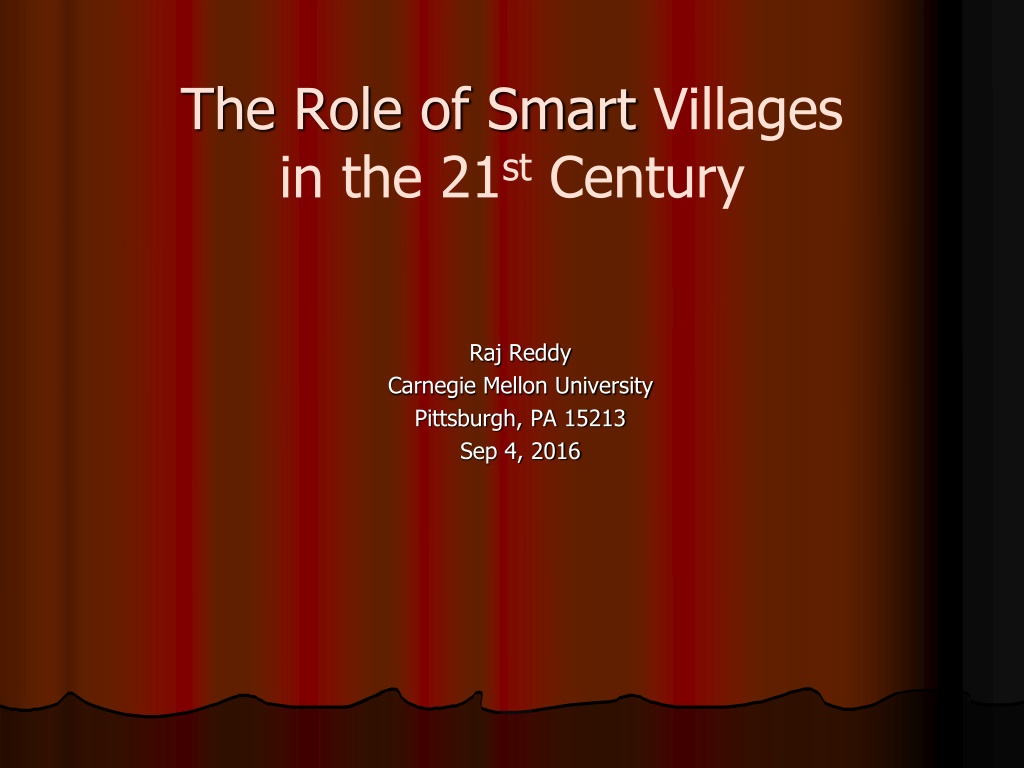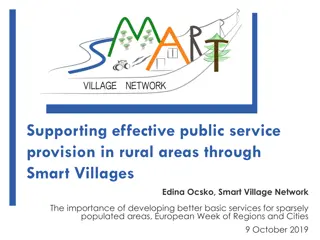The Role of Smart Villages in the 21st Century
Smart Villages offer simpler solutions compared to Smart Cities, aiming to provide essential services and facilities to rural communities without the need for migration to urban areas. By leveraging 21st-century technologies and upgrading existing amenities, Smart Villages can become self-sustaining, self-sufficient hubs that cater to the needs of their populations. Through IT-enabled solutions and necessary infrastructure like solar energy and digital literacy programs, Smart Villages can bridge the gap between rural and urban living, ensuring connectivity and access to vital services.
Download Presentation

Please find below an Image/Link to download the presentation.
The content on the website is provided AS IS for your information and personal use only. It may not be sold, licensed, or shared on other websites without obtaining consent from the author.If you encounter any issues during the download, it is possible that the publisher has removed the file from their server.
You are allowed to download the files provided on this website for personal or commercial use, subject to the condition that they are used lawfully. All files are the property of their respective owners.
The content on the website is provided AS IS for your information and personal use only. It may not be sold, licensed, or shared on other websites without obtaining consent from the author.
E N D
Presentation Transcript
The Role of Smart Villages in the 21stCentury Raj Reddy Carnegie Mellon University Pittsburgh, PA 15213 Sep 4, 2016
Lot of Hype about Smart Cities Lot of Interest and Activity in Advancing the Technology Of Smart Cities. The Sheer Scale and Scope of Providing Essential Services in a City of 10 Million Can Be Daunting. Cities Also Have Problems of Crime, Homelessness, Migrant Families etc. Smart Villages, on The Other-hand, may be Amenable to Simpler Solutions. To Control The Growth Of Cities Need To Develop Smart Villages That Provide Many Of The Same Facilities And Services As In Cities Making It Unnecessary For Village Populations To Migrate To Cities.
Usually Existing Amenities in Villages Villages Evolved Through the Ages as Self Sustaining Self Sufficient Communities Villages Usually Have Access to Water Food Housing Sanitation But Need Knowledge and Resources to Upgrade to 21st Century Solutions while Ensuring Self Sustaining Self Sufficient Character
Some Amenities of Smart Cities Not Needed in Smart Villages Smart Villages May Not Need Expensive Infrastructure of 20thCentury Electric Grid Roads Railways Airports Leapfrog to 21stCentury Solutions Use Solar Power Use Autonomous Land, Sea, and Air Vehicles Self driving cars Drones
Providing Missing Amenities in Villages Technology to the Rescue: Create Smart Villages IT Enabled Solutions for Education Entertainment Health Care Medical Supplies Shopping Banking Voting Necessary Conditions Connectivity: Balloon, Solar Drones or Satellite Computing: Smat Phones and iPads Digital Literacy Apps for Education, Entertainment etc.
Necessary Conditions Infrastructure in Every Village Solar Energy Wi-Fi Connectivity Smart Phone/Tablet for Everyone Digital Literacy Village Centric Apps Speech To Speech Dialog Based Interfaces for Semi-literate Populations
In Conclusion We Need to Develop Smart Villages in Addition to Smart Cities By Providing IT Enabled Solutions for Education Entertainment Health Care Medical Supplies Shopping Banking Voting In Every Village

 undefined
undefined
























